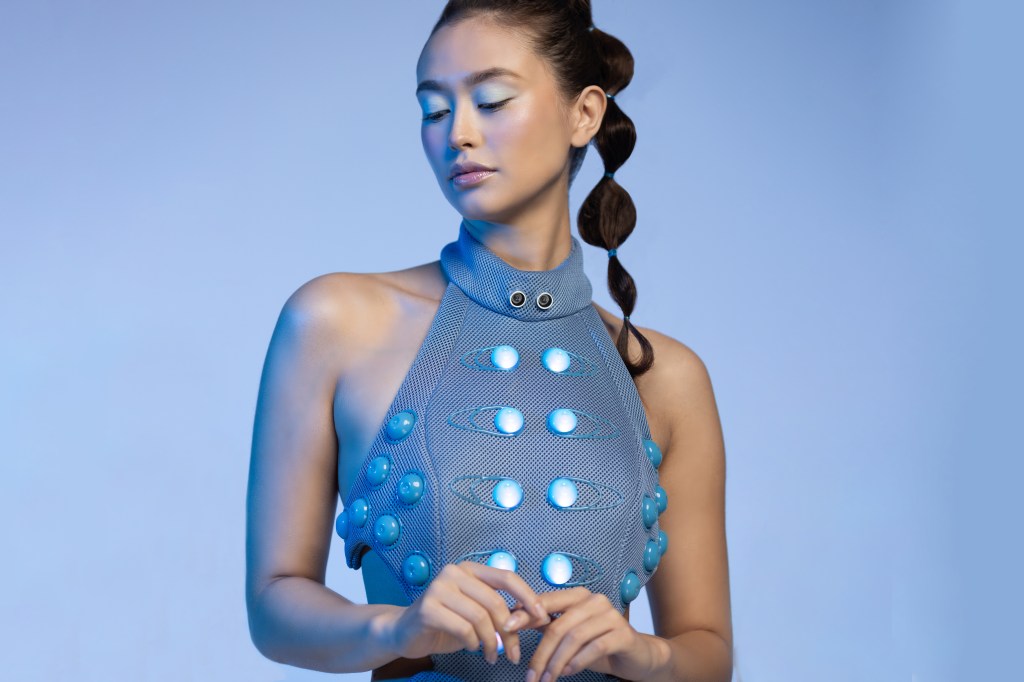While some designers would welcome a wide-open field, FashionTech designer Anouk Wipprecht would like to see more creatives diving into her sector.
Wipprecht has combined robotics, electronics and sensors into her designs since early the 2000s, when “computers were huge and hard to program,” she said. Now — 22 years later — electronics are “small, fairly cheap, easy to integrate and smart,” meaning integrating machine learning or any kind of learning systems can lead to “all kinds of cool things.”
Wipprecht said FashionTech combines design, fashion, coding, engineering, robotics, science, architecture, and even things like psychology and anthropology. Still “a pretty hybrid profession,” being in the FashionTech field has enabled her to redesign medical devices with more of a fashion spin so the wearer feels “less like a patient,” she said. Her portfolio includes working on a spacesuit, beta-testing new technologies, making a smart fabric meant to transmit the wearer’s brain signals and working on a prosthetic leg.
“It’s not just dresses that ‘do’ things, there is a whole universe of things that you can do around the body. I also have a lot of [interest from] companies that somehow never could make the connection to ‘analogue’ fashion [before.] But now all of a sudden, they can enter the fashion field, since technology is involved in a fun and exciting way,” she said.
For those interested in FashionTech, she advised starting small. “Think of small projects that you can start and learn from, and then go deeper. Make your code more difficult, design and 3D print enclosures for your sensors and so on. Learn, play. That is my biggest advice,” she said. “The world opens up when you know how to code and engineer. It’s a skill that you can use for a lot of things.”
She recently created a prototype 3D-printed dress that responds to its environment with LEDs. Now based in Woodstock, N.Y., the Dutch designer joined forces with Chromatic 3D for the project that plays up a new 3D printing process that allows for printing in rubber-like materials like elastomer.
“To get really nerdy, it is called reactive extrusion additive manufacturing. It is deposition printing with reactive chemicals. Basically, a reaction starts inside the printer head, triggering a bonding process that yields industrial-strength elastomers and other commercial-ready materials,” Wipprecht said.
That translates to 3D printing that uses chemical reaction on textiles. Wipprecht said that was used to not only 3D-print on textiles in elastomer, which makes the print flexible, but also to embed LED lights. By enclosing and encapsulating electronic parts like a small LED light, the garment becomes waterproof and protects the electronics. That feature can allow for washability and a more durable way to embed electronics and sensors on the body, the designer said.
The Minneapolis-based Chromatic 3D Materials debuted the design in Frankfurt at the Formnext trade show, which wraps up Friday.
The choice of slightly translucent dye and pigments for the elastomer worked well in terms of illuminating light and served as a diffuser. The dress was made with a built-in proximity sensor, so that when people are close to the wearer, the sensor detects that and illuminates. Wipprecht said, “Fireflies produce light through a chemical reaction in their glowing abdomens, a process known as bioluminescence.…The bright signal can startle and distract.”
The way the designer sees things, it comes down to a matter of personal space, with the dress signaling to the wearer where exactly their personal space starts.
Wipprecht noted how 3D textile printing has been explored a good deal in the maker scene, including with some makers printing textiles with their PLA printers. In addition, industrial companies are trying their hand at it too, but brittleness can be an issue for some, she said.
Wipprecht contended that we are “living in such a cool time in when the electronics around us not only start to ‘hear’ us, but ‘feel’ us soon, too. Technology came into our lives to ‘help us,’ but our handheld devices often overwhelm us instead. This is mainly because they don’t really take our mood or emotions in consideration.” The designer floated the prospect of using technologies like a second skin to measure the wearer’s stress levels or needs to create a new way to interface with the world in a more sensitive matter. She added, “Fashion is about expressing ourselves nonverbally. For me, that is a natural next step of where technology will go — to ‘feel’ with us or sense us.”



